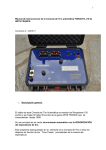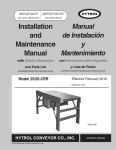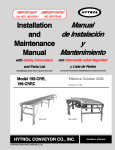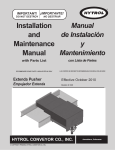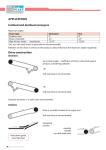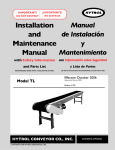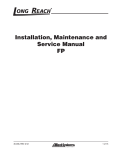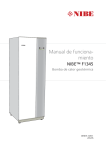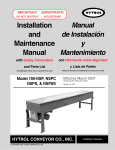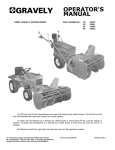Download Instalación y Mantenimiento - Hytrol Conveyor Company, Inc.
Transcript
IMPORTANT! ¡IMPORTANTE! DO NOT DESTROY NO DESTRUIR Manual Installation de Instalación and y Maintenance Mantenimiento Manual with Safety Information con Información sobre Seguridad and Parts List y Lista de Partes RECOMMENDED SPARE PARTS HIGHLIGHTED IN GRAY LAS PARTES DE REPUESTO RECOMENDADAS SE RESALTAN EN GRIS High Speed Pusher (Empujador de Alta Velocidad) Effective February 2005 (Supercedes September, 2000) Bulletin # 540 HYTROL CONVEYOR CO., INC. © COPYRIGHT 2005–HYTROL CONVEYOR CO., INC. Jonesboro, Arkansas ● Table of Contents Warning Signs . . . . . . . . . . . . . . . . . . . . .3 Señales de Advertencia . . . . . . . . . . . . .3 INTRODUCTION Receiving and Uncrating . . . . . . . . . . . . .4 INTRODUCCION Recepción y Desembalaje . . . . . . . . . . . .4 INSTALLATION Installation Safety Precautions For Conveyors and Related Equipment . . .5 Assembly . . . . . . . . . . . . . . . . . . . . . . . . .6 Electrical Equipment . . . . . . . . . . . . . . . .8 Wiring Diagrams . . . . . . . . . . . . . . . . . . .9 OPERATION Operation Safety Precautions . . . . . . . .10 Sequence of Operation–Manual . . . . . .11 Sequence of Operation–Automatic . . . .12 Stroke Length/Proximity Switch Adjustment . . . . . . . . . . . . . . . . . . . . . .16 Speed (Main Air Pressure) Adjustment .17 Cushion Adjustment . . . . . . . . . . . . . . .18 Ram Guide Adjustment . . . . . . . . . . . . .19 MAINTENANCE Maintenance Safety Precautions . . . . . .20 Lubrication . . . . . . . . . . . . . . . . . . . . . . .20 Preventive Maintenance Checklist . . . .21 How to Order Replacement Parts . . . . .21 Trouble Shooting . . . . . . . . . . . . . . . . . .22 PARTS DRAWINGS AND LIST Model HSP Parts Drawing . . . . . . . . . . .23 Pneumatic Kit . . . . . . . . . . . . . . . . . . . .26 Model HSP Parts List . . . . . . . . . . . . . .27 2 ● Tabla de Contenido INSTALACION Medidas de Seguridad para Transportadores y Equipo Relacionado . . . . . . . . . . . . . . . . . . . . .5 Ensamble . . . . . . . . . . . . . . . . . . . . . . . . .6 Equipo Eléctrico . . . . . . . . . . . . . . . . . . .8 Diagramas de Cableado . . . . . . . . . . . . .9 OPERACION Medidas de Seguridad . . . . . . . . . . . . .10 Secuencia de Operación-Manual . . . . .11 Secuencia de Operación-Automática . .14 Longitud de Carrera / Ajuste del Interruptor de Proximidad . . . . . . . . . .16 Ajuste de Velocidad (Presión Principal de Aire ) . . . . . . . . .17 Ajuste de Amortiguación . . . . . . . . . . . .18 Ajuste de Guía del Brazo . . . . . . . . . . .19 MANTENIMIENTO Medidas de Seguridad . . . . . . . . . . . . .20 Lubricación . . . . . . . . . . . . . . . . . . . . . .20 Lista del Plan de Mantenimiento . . . . . .21 Como Ordenar Partes de Repuesto . . .21 Resolviendo Problemas . . . . . . . . . . . .22 DIBUJO Y LISTA DE PARTES Dibujo de Partes del Modelo HSP . . . .23 Equipo Neumático . . . . . . . . . . . . . . . . .26 Lista de Partes del Modelo HSP . . . . . .27 ● Warning Signs ● Señales de Advertencia In an effort to reduce the possibility of injury to personnel working around HYTROL conveying equipment, warning signs are placed at various points on the equipment to alert them of potential dangers. Please check equipment and note all warning signs. Make certain your personnel are alerted to and obey these warnings. Shown below are typical signs that are attached to this equipment. En un esfuerzo por reducir la posibilidad de accidentes al personal trabajando junto al equipo de transportación HYTROL, se colocan señales de advertencia en diferentes puntos del equipo para alertarlos de riesgos potenciales. Por favor verifique el equipo y asegúrese de ver todas las señales de advertencia. Asegúrese de que su personal esté alerta y obedezca las señales. Abajo se muestran las señales que se encuentran en este equipo. PLACED ON ALL POWERED CONVEYORS NEAR DRIVE AND/OR CONTROLS. COLOCADA EN TODOS LOS TRANSPORTADORES MOTORIZADOS CERCA AL MOTOR Y/O LOS CONTROLES PLACED ON ALL CHAIN GUARDS. COLOCADA EN TODAS LAS GUARDA CADENAS. PLACED NEXT TO DRIVE, BOTH SIDES. COLOCADA JUNTO A LA UNIDAD MOTRIZ, EN AMBOS LADOS. PLACED ON 20 FT. INTERVALS,BOTH SIDES. COLOCADA EN INTERVALOS DE 20 PIES, A AMBOS LADOS. PLACED ON TERMINATING ENDS. COLOCADA EN LOS EXTREMOS. PLACED AT DRIVE OF ALL POWERED CONVEYORS. COLOCADA EN LA UNIDAD MOTRIZ DE TODOS LOS TRANSPORTADORES MOTORIZADOS. PLACED ON LINE SHAFT SIDE. COLOCADA EN EL LADO DE LA LÍNEA EJE. NOTE: BILINGUAL (SPANISH) LABELS AVAILABLE UPON REQUEST. NOTA: ETIQUETAS BILINGÜES (ESPAÑOL) SERÁN PROVEÍDAS BAJO PETICIÓN. 3 INTRODUCTION This manual provides guidelines and procedures for installing, operating, and maintaining your high speed pusher. A complete parts list is provided with recommended spare parts highlighted in gray. Important safety information is also provided throughout the manual. For safety to personnel and for proper operation of your pusher, it is recommended that you read and follow the instructions provided in this manual. ● Receiving and Uncrating 4 INTRODUCCION Este manual provee las pautas y los procedimientos para instalar, operar y mantener su empujador de alta velocidad. Se proporciona una lista completa de partes, con partes de repuesto recomendadas que se resaltan en gris. También se proporciona información importante de seguridad a lo largo de este manual. Para seguridad del personal y para un funcionamiento apropiado del empujador de alta velocidad, se recomienda que lean y sigan las instrucciones proporcionadas en este manual. ● Recepción y Desembalaje 1. . . Check the number of items received against the bill of lading. 2. . . Examine condition of equipment to determine if any damage occurred during shipment. 3. . . Move all crates to area of installation. 4. . . Remove crating and check for optional equipment that may be fastened to the equipment. Make sure these parts (or any foreign pieces) are removed. 1. . .Verifique el número de partes recibidas con respecto al conocimiento de embarque. 2. . .Examine las condiciones del equipo con el fin de determinar si algún daño ha ocurrido durante el transporte. 3. . .Traslade todo el equipo al área de instalación. 4. . .Remueva todos los empaques y verifique si hay partes opcionales que puedan estar atadas al equipo. Asegúrese de que estas partes (u otras partes externas) sean removidas. NOTE: If damage has occurred or freight is missing, see the “Important Notice” attached to the crate. NOTA: Si algún daño ha ocurrido o falta cargamento, vea las “Notas Importantes” adheridas al embalaje. INSTALLATION INSTALACION ● Installation Safety Precautions ● Medidas de Seguridad al Instalar GUARDS AND GUARDING Interfacing of Equipment. When two or more pieces of equipment are interfaced, special attention shall be given to the interfaced area to insure the presence of adequate guarding and safety devices. Guarding Exceptions. Wherever conditions prevail that would require guarding under these standards, but such guarding would render the conveyor unusable, prominent warning means shall be provided in the area or on the equipment in lieu of guarding. Guarded by Location or Position. Where necessary for the protection of employees from hazards, all exposed moving machinery parts that present a hazard to employees at their work station shall be mechanically or electrically guarded, or guarded by location or position. When a conveyor passes over a walkway, roadway, or work station, it is considered guarded solely by location or position if all moving parts are at least 8 ft. (2.44 m) above the floor or walking surface or are otherwise located so that the employee cannot inadvertently come in contact with hazardous moving parts. Although overhead conveyors may be guarded by location, spill guard, pan guards, or equivalent shall be provided if the product may fall off the conveyor for any reason and if personnel would be endangered. GUARDAS Y PROTECCIONES Unión del Equipo. Cuando dos o más piezas del equipo van unidas, debe ponerse especial atención al área de unión para asegurar que las guardas adecuadas y los dispositivos de seguridad estén presentes. Excepciones de Protección. Dondequiera que las guardas sean necesarias, pero que la colocación de las mismas inhabilite el uso del transportador, se proporcionarán señales de advertencia visibles en el área o en el equipo en vez de las guardas. Protección dada por Posición o Ubicación. Cuando sea necesaria la protección de los empleados contra posibles riesgos, todas las partes del equipo que estén expuestas y en movimiento, y que puedan presentar un peligro para ellos en sus puestos de trabajo, serán protegidas mecánica o eléctricamente, o protegidas por su posición o ubicación. Cuando el transportador está instalado sobre pasillos, corredores o puestos de trabajo, se considera que está protegido únicamente por localización o posición si todas las partes en movimiento están mínimo a 8 pies (2.44m) de altura del piso, o si está localizado de tal manera que el empleado no pueda entrar en contacto inadvertidamente con dichas partes. A pesar de que los transportadores aéreos pueden estar protegidos por localización, guardas laterales e inferiores deben ser proporcionadas para evitar que el producto se caiga del transportador y así mantener al personal fuera de peligro. for Conveyors and Related Equipment HEADROOM When conveyors are installed above exit passageways, aisles, or corridors, there shall be provided a minimum clearance of 6 ft. 8 in. (2.032 m) measured vertically from the floor or walking surface to the lowest part of the conveyor or guards. Where system function will be impaired by providing the minimum clearance of 6 ft. 8 in. (2.032 m) through an emergency exit, alternate passageways shall be provided. It is permissible to allow passage under conveyors with less than 6 ft. 8 in. (2.032 m) clearance from the floor for other than emergency exits if a suitable warning indicates low headroom. Transportadores y Equipos Relacionados UBICACION SUPERIOR Cuando los transportadores son instalados sobre pasillos o corredores de salida, debe dejarse un espacio libre de mínimo 6 pies 8 pulgadas (2,032m), medido verticalmente desde el piso o área de tránsito hasta la parte más baja del transportador o de las guardas. Si se proporcionan señales de advertencia adecuadas indicando baja altura, es posible dejar espacio libre con menos de 6 pies 8 pulgadas (2,032m) entre el piso y el transportador en los pasillos que no sean salidas de emergencia. 5 ● Assembly ● Ensamble The High Speed Pusher comes completely assembled except for installing supports, connecting air and electrical supply, and mounting to conveyor. El Empujador de Alta Velocidad viene completamente ensamblado con excepción de los soportes, las conexiones a las fuentes eléctricas y de aire, y el montaje al transportador. If pusher is to be mounted to a new conveyor, install conveyor as described in the installation and maintenance manual for the conveyor. Si el Empujador va a ser instalado en un transportador nuevo, instale el transportador como se describe en su propio manual de instalación y mantenimiento. Instructions for installing the pusher are as follows: Las instrucciones para instalar el empujador son las siguientes: MOUNTING TO CONVEYOR 1. . . Determine location of pusher by finding center line of take-away conveyor. (Figure 7B). 2. . . Fasten mounting angles to conveyor frame as shown in Figure 7B. NOTE: If pusher is mounting to 138-SP or 190-SP conveyors, spacers are supplied to locate mounting angles below the line shaft guard. (Figure 7A, Detail “A”). 3. . . Attach rear support to spacer channels on rear of pusher (Figure 7A). Preset support to same height as conveyor supports. 4. . . Set pusher in place with front support spacer resting on mounting angles. Fasten with 3/8 in. bolts. (Figure 7A). 5. . . Lag rear support to floor. 6. . . Pull ram out so ram face is above the opposite channel from the pusher. Adjust rear support so there is approximately one inch clearance between the bottom of ram face and the conveying surface. AIR SUPPLY 7. . . Connect main air line to FRL (Filter / Regulator / Lubricator). Figure 7C. 8. . . Set working pressure on main regulator and cushion regulator as described in the speed adjustment (main air) and cushion adjustment instructions on Page 17. NOTE: See Packing Envelope for maintenance instructions on How To Adjust and Lubricate the FRL. ELECTRICAL 9. . . Install electrical controls and connect to control boxes. See Pages 8 and 9. (Also, see inside the conduit box.) MONTAJE AL TRANSPORTADOR 1. . . Encuentre la línea central del transportador para determinar la ubicación del empujador. (Figura 7B). 2. . . Asegure los ángulos de montaje al canal del transportador como se muestra en la Figura 7B. NOTA: Si el empujador es instalado en transportadores Modelo 138-SP o 190-SP, se proporcionan espaciadores para ubicar los ángulos de montaje debajo de la guarda del eje lineal. (Figura 7A, Detalle "A"). 3. . . Fije el soporte trasero a los canales espaciadores en la parte trasera del empujador. (Figura 7A). Ajuste previamente el soporte a la misma altura de los soportes del transportador. 4. . . Ubique el empujador en su lugar, con el espaciador del soporte delantero descansando sobre los ángulos de montaje. Asegure con tornillos de 3/8". (Figura 7A). 5. . . Ancle el soporte trasero al piso. 6. . . Saque el brazo del empujador de manera que la parte delantera del brazo quede por encima del canal opuesto al empujador. Ajuste el soporte trasero de manera que quede aproximadamente una pulgada de espacio entre la base del brazo y la superficie de transportación. SUMINISTRO DE AIRE 7. . . Conecte la línea principal de aire al FRL (Filtro / Regulador / Lubricador). Figura 7C. 8. . . Fije la presión de trabajo en el regulador principal y amortigue el regulador como se describe en las instrucciones de ajuste de velocidad (suministro principal de aire) y ajuste de amortiguación en la Página 17. Nota: Vea el Sobre de Empaque para instrucciones de mantenimiento sobre Como Ajustar y Lubricar el FRL. ELECTRICOS 9. . . Instale los controles eléctricos y conéctelos a las cajas de controles. Vea páginas 8 y 9. (Vea también el interior de la caja del conductor). 6 FIGURE 7A FIGURE 7B FIGURE 7C 7 ● Electrical Equipment ● Equipo Eléctrico WARNING! Electrical controls shall be installed and wired by a qualified electrician. Wiring information for the motor and controls are furnished by the equipment manufacturer. ¡ADVERTENCIA! Los controles eléctricos deben ser conectados e instalados por un electricista calificado. La información sobre el cableado del motor y los controles será proporcionada por el fabricante del equipo. CONTROLS CONTROLES Electrical Code: All motor controls and wiring shall conform to the National Electrical Code (Article 670 or other applicable articles) as published by the National Fire Protection Association and as approved by the American Standards Institute, Inc. Código Eléctrico: Todo Equipo Eléctrico y las conexiones deben ajustarse al “National Electrical Code” (Artículo 670 u otros artículos aplicables) como fue publicado por la “National Fire Protection Association” y aprobado por el “American Standards Institute, Inc”. CONTROL STATIONS ESTACIONES DE CONTROL A) Control stations should be so arranged and located that the operation of the equipment is visible from them, and shall be clearly marked or labeled to indicate the function controlled. A) Las estaciones de control deberán estar arregladas y ubicadas en lugares donde el funcionamiento del equipo sea visible y deberán estar claramente marcadas o señaladas para indicar la función controlada. SAFETY DEVICES DISPOSITIVOS DE SEGURIDAD A) All safety devices, including wiring of electrical safety devices, shall be arranged to operate in a “Fail-Safe” manner, that is, if power failure or failure of the device itself would occur, a hazardous condition must not result. A) Todos los dispositivos de seguridad, incluyendo la conexión de dispositivos eléctricos, deben estar dispuestos para operar en una manera de “autoprotección”; es decir, si se presenta una pérdida de corriente o un fallo en el mismo dispositivo, esto no debe resultar en una situación peligrosa. B) Emergency Stops and Restarts. Conveyor controls shall be so arranged that, in case of emergency stop, manual reset or start at the location where the emergency stop was initiated, shall be required of the conveyor(s) and associated equipment to resume operation. C) Before restarting a conveyor which has been stopped because of an emergency, an inspection of the conveyor shall be made and the cause of the stoppage determined. The starting device shall be locked out before any attempt is made to remove the cause of stoppage, unless operation is necessary to determine the cause or to safely remove the stoppage. Refer to ANSI Z244.1-1982, American National Standard for Personnel Protection – Lockout/Tagout of Energy Sources – Minimum Safety Requirements and OSHA Standard Number 29 CFR 1910.147 “The Control of Hazardous Energy (Lockout/Tagout).” 8 B) Paradas de Emergencia y Reactivadores. Los controles del transportador deberán estar dispuestos de tal manera que, en caso de una parada de emergencia, se requiera un activador o un arrancador manual en el lugar donde la parada de emergencia se presente para reanudar la operación del transportador o transportadores y el equipo asociado. C) Antes de reiniciar un transportador que ha sido detenido por una emergencia, debe realizarse una revisión del transportador y determinarse la causa de la parada. El dispositivo de arranque deberá ser bloqueado antes de intentar corregir el problema, a no ser que la operación del transportador sea necesaria para determinar la causa de la parada o para solucionar el problema. Refiérase al ANSI Z244.1-1982, American National Standard for Personnel Protection - Lockout/Tagout of Energy Sources - Minimum Safety Requirements and OSHA Standard Number 29 CFR 1910.147 “The Control of Hazardous Energy (Lockout/Tagout).” ● Diagramas de Cableado ● Wiring Diagrams STANDARD AC POWER SUPPLY (120 Volt-60 Hz.-Single Phase) (FUENTE DE PODER ESTANDAR AC) [120 Volt-60 Hz.-Una Fase] STANDARD CONNECTION AS WIRED AT FACTORY MODIFIED FOR PLC CONTROL WITH HOME POSITION PROXIMITY SWITCH (CONEXION ESTANDAR REALIZADA EN LA FABRICA) (CONEXION MODIFICADA PARA CONTROL PLC CON INTERRUPTOR DE PROXIMIDAD EN LA POSICION DE RETRACCION) FIGURE 9A FIGURE 9B NOTE: CONTACT “X” REQUIRES 150-200 MILLISECOND CLOSED TIME (NOT SUPPLIED). NOTA: SE REQUIERE UN TIEMPO DE CONTACTO EN “X” DE 150-200 MILISEGUNDOS 9 OPERATION ● Operation Safety Precautions A) Only trained employees shall be permitted to operate conveyors. Training shall include instruction in operation under normal conditions and emergency situations. B) Where employee safety is dependent upon stopping and/or starting devices, they shall be kept free of obstructions to permit ready access. C) The area around loading and unloading points shall be kept clear of obstructions which could endanger personnel. D) A conveyor shall be used to transport only material it is capable of handling safely. E) Under no circumstances shall the safety characteristics of the conveyor be altered if such alterations would endanger personnel. F) Routine inspections and preventive and corrective maintenance programs shall be conducted to insure that all safety features and devices are retained and function properly. 10 OPERACION ● Medidas de Seguridad en la Operación A) Solo se deberá permitir operar los transportadores a empleados entrenados. El entrenamiento debe incluir instrucciones de operación bajo condiciones normales y en situaciones de emergencia. B) Cuando la seguridad de los trabajadores depende de dispositivos de parada y/o arranque, tales dispositivos deben mantenerse libres de obstrucciones para permitir un acceso rápido. C) El área alrededor de los puntos de carga y descarga deberá mantenerse libre de obstrucciones, las cuales podrían poner en peligro al personal. D) Un transportador deberá ser utilizado para transportar solamente los productos que sea capaz de manejar en forma segura. E) Bajo ninguna circunstancia deberán ser alteradas las características de seguridad de un transportador si tales alteraciones pudieran poner en peligro al personal. F) Inspecciones rutinarias deberán llevarse a cabo al igual que programas de mantenimiento preventivo y correctivo, con el fin de asegurar que todos los dispositivos y medidas de seguridad se conserven en buen estado y funcionen correctamente. OPERATION OPERACION ● Sequence of Operation– MANUAL ● Secuencia de OperaciónMANUAL Prior to automatic operation, the high speed pusher should be manually cycled to see that it is operating freely in both directions and that the speed and cushion features have been adjusted properly. A test switch (Figure 11A) mounted to the conduit box is provided for this purpose. Antes de la operación automática, el empujador de alta velocidad debe ser operado manualmente para revisar que funcione libremente en ambas direcciones y que las características de velocidad y amortiguación hayan sido ajustadas apropiadamente. Un interruptor de prueba (Figura 11A) instalado en la caja del conductor se provee para este propósito. TEST (To Manually Cycle Pusher) 1. . . Read the instructions on Pages 17 and 18 on How To Adjust the Speed and Cushion Features. 2. . . Cycle pusher by moving the toggle switch to the “test” position. NOTE: Do not hold in this position–Release switch as soon as pusher begins cycle. 3. . . Observe operation and make necessary adjustments as described in the adjustment instructions. RESET 4. . . The 3-Position Selector Switch switch also has a “reset” position. If, because of an incorrect adjustment of main air pressure, cushion air pressure, flow control valve, etc., the ram jams in a partially extended position, moving the 3-Position Selector Switch to “reset” will cause the ram to fully retract. WARNING! Make sure all personnel are clear of ram area during operation. Also, remove any foreign objects that could damage pusher from this area. PRUEBA (Para Operar Manualmente el Empujador) 1. . . Lea las instrucciones en la páginas 17 y 18 acerca de Como Ajustar las Características de Velocidad y Amortiguación. 2. . . Iniciar la operación del empujador moviendo el interruptor de palanca a la posición "prueba" (Test). NOTA: No mantenga el interruptor en esta posición. Suéltelo tan pronto como el empujador empiece a operar. 3. . . Observe la operación y haga los ajustes necesarios como se describe en las instrucciones de ajuste. REINICIAR 4. . . El interruptor selector de tres posiciones cuenta también con una posición de "reinicio" (Reset). Si el brazo se atasca en una posición de parcial extensión como consecuencia de un ajuste incorrecto de la presión de aire principal, de la presión de aire de amortiguación, de la válvula de control de flujo, etc., se debe mover el interruptor selector de tres posiciones a "reinicio" para que el brazo se retraiga completamente. FIGURE 11A CONDUIT BOX (CAJA DEL CONDUCTOR) (REINICIAR) (PRUEBA) ¡ADVERTENCIA! Asegúrese que todo el personal este alejado del área del brazo durante la operación. Además, remueva del área cualquier objeto extraño que pudiera dañar el empujador. THREE POSITION SELECTOR SWITCH (INTERRUPTOR SELECTOR DE TRES POSICIONES) 11 ● Sequence of Operation–AUTOMATIC The High Speed Pusher is comprised of a number of pneumatic and electrical parts to sense the position of the ram. (Figure 12A). One cycle of the pusher is described in the following sequence. RAM FULLY RETRACTED (Figure 12A) When the pusher is in the stand-by mode (retracted), air is supplied through the main air valve (1) to the retract end of the cylinder (3), holding the ram (7) in the retracted position. Proximity switch P3 (10), the home position sensor, is activated. 2. . . SIGNAL TO BEGIN CYCLE (Figure 13A) Contact “X” is closed momentarily. (This is the signal from a photo-eye, programmable controller, etc., to activate the pusher.) Solenoid #1 is energized which shifts the main air valve (1), sending air to the extend end of the cylinder (3) to begin the cycle. As the ram extends, P-3 is deactivated. FIGURE 12A ITEM DESCRIPTION 1 MAIN AIR VALVE–SOLENOID OPERATED 2 CUSHION AIR VALVE– SOLENOID OPERATED 3 AIR CYLINDER 4 MUFFLER ASSEMBLY 5 MUFFLER 6 FLOW CONTROL VALVE 7 RAM 8 PROXIMITY SWITCH P-1 (RETRACT) 9 PROXIMITY SWITCH P-2 (CUSHION) 12 10 11 12 13 14 PROXIMITY SWITCH P-3 (HOME) SHUT-OFF VALVE MAIN REGULATOR W/FILTER & LUBRICATOR (FRL) CUSHION REGULATOR AIR SUPPLY LINES MAIN AIR SUPPLY NO AIR PRESSURE CUSHIONED AIR ● Sequence of Operation–AUTOMATIC 3. . . BEGINNING OF RETRACT STROKE (Figure 13B) As the ram nears the end of the extend stroke, it activates P-1 (8), which in turn activates solenoid #2 of the main air valve. Air is shifted from the extend end of the cylinder to the retract end, causing the ram to begin the retract stroke. (The ram is reversed before the cylinder is fully extended to cushion the stroke.) 4. . . END OF RETRACT STROKE (Figure 13C) As the ram approaches the end of the retract stroke, it activates P-2 (9), which in turn activates solenoid #3 of the cushion air valve (2). This sends a burst of air into the extend end of the cylinder, cushioning the impact of the ram as it returns to the fully retracted position. NOTE: Some of the cushion air is allowed to exhaust through the main air valve and through a flow control valve (6), which allows the cushioning action to be adjusted for proper operation. FIGURE 13A FIGURE 13B NOTES: 1. . . The above sequence is for the pusher as it is wired at the factory. (See Wiring Diagram on Page 9–Figure 9A). In this configuration P-3, the home position sensor, is wired in series with the test switch, and is used to override the activation signal, to insure the signal is a pulse. If the test switch is held closed, the pusher will continue to cycle. 2. . . The pusher may be re-wired to bypass P-3, which can then be used to signal a programmable controller or other device when the ram is fully retracted. (See Figure 9B). FIGURE 13C CAUTION! The activation signal must be a pulse of no more than 200 milliseconds. A longer signal will override the retract signal given by P-1, allowing the ram to overextend and “bottomout”, possibly damaging the cylinder. 13 ● Secuencia de Operación – Automática El empujador de alta velocidad incluye un número de partes neumáticas y eléctricas para percibir la posición del brazo. (Figura 14A). La siguiente secuencia describe un ciclo del empujador. 1. . . BRAZO TOTALMENTE RETRAIDO (Figura 14A) Cuando el empujador está en el modo stand-by (retraído), se suministra aire a través de la válvula principal de aire (1) al extremo retractor del cilindro (3), manteniendo así el brazo (7) en posición de retracción. El interruptor de proximidad P3 (10), sensor de la posición de retracción, es activado. 2. . . SEÑAL PARA COMENZAR EL CICLO (Figura 15A) El contacto "X" se cierra momentariamente. (Esta es la señal de la foto-celda, del controlador programable, etc., para activar el empujador.) El solenoide #1 recibe energía y activa la válvula principal de aire (1), enviando aire al extremo extensor del cilindro (3) para comenzar el ciclo. A medida que el brazo se extiende, P3 es desactivado. FIGURA 14A ITEM DESCRIPCION 1 VALVULA PRINCIPAL DE AIRE OPERADA POR SOLENOIDE 2 VALVULA DE AIRE DE AMORTIGUACION 3 CILINDRO DE AIRE 4 ENSAMBLE DEL ESCAPE 5 ESCAPE 6 VALVULA DE CONTROL DE FLUJO 7 BRAZO 8 INTERRUPTOR DE PROXIMIDAD P-1 (RETRACTOR) 9 INTERRUPTOR DE PROXIMIDAD P-2 (AMORTIGUACION) 14 10 INTERRUPTOR DE PROXIMIDAD P-3 (INICIO) 11 VALVULA DE APAGADO 12 REGULADOR PRINCIPAL CON FILTRO Y LUBRICADOR (FRL) 13 REGULADOR DE AMORTIGUACION 14 LINEAS DE SUMINISTRO DE AIRE FUENTE PRINCIPAL DE AIRE SIN PRESION DE AIRE AIRE AMORTIGUADO ● Secuencia de Operación – Automática 3. . . INICIO DE LA CARRERA DE RETRACCION (Figura 15B) A medida que el brazo se aproxima al final de la carrera de extensión, este activa P-1(8), el cual activa a su vez el solenoide #2 de la válvula principal de aire. El aire se transfiere del extremo extensor del cilindro al extremo retractor, causando que el brazo comience la carrera de retracción. (El brazo da marcha atrás antes de que el cilindro se extienda totalmente para amortiguar la carrera.) 4. . . FINAL DE LA CARRERA DE RETRACCION (Figura 15C) A medida que el brazo se aproxima al final de la carrera de retracción, este activa P-2 (9), el cual activa a su vez el solenoide #3 de la válvula de aire de amortiguación (2). Esta envía una ráfaga de aire dentro del extremo extensor del cilindro, amortiguando el impacto del brazo a medida que este vuelve a la posición de total retracción. NOTA: Parte del aire de amortiguación escapa a través de la válvula principal de aire y de la válvula de control de flujo (6), lo cual permite que la acción de amortiguación sea ajustada para una operación apropiada. FIGURA 15A SEÑAL PARA COMENZAR EL CICLO FIGURA 15B NOTAS: 1. . . La secuencia anterior es para el empujador que presenta la conexión hecha en la fábrica. (Vea el Diagrama de Conexión de la Página 9-Figura 9A). En esta configuración P-3, el sensor de la posición inicial, es conectado en serie con el interruptor de prueba, y se usa para invalidar la señal de activación, para asegurar que la señal sea un pulso. Si el interruptor de prueba se mantiene cerrado, el empujador continuará su ciclo. FIGURA 15C 2. . . El empujador puede ser re-conectado evitando P-3, el cual puede ser usado para enviar una señal a un controlador programable o a otro dispositivo cuando el brazo se retrae totalmente. (Ver Figura 9B). ¡PRECAUCION! La señal de activación deber ser un pulso de no más de 200 milisegundos. Una señal mas larga invalidará la señal de retracción dada por P1, permitiendo así que el brazo se sobreextienda y dañe posiblemente el cilindro. 15 ● Stroke Length/ ● Longitud de Carrera / Ajuste del Interruptor de Proximidad The High Speed Pusher is available in three stroke length ranges: 14"-18", 18"-24", and 24"-30". The stroke length may be set at any point within the range of each model. Stroke may be varied by adjusting the extend proximity switch (P-1). This procedure, as well as other adjustments required to set the proximity switches, are described below. El Empujador de Alta Velocidad está disponible en tres rangos de longitud de carrera: 14"- 18", 18"- 24" y 24"30". La longitud de carrera se puede fijar en cualquier punto dentro del rango de cada modelo. Esta se puede modificar mediante el ajuste del interruptor de proximidad del extensor (P-1). Este procedimiento, como otros ajustes requeridos en los interruptores de proximidad se describen a continuación. Proximity Switch Adjustment STROKE LENGTH ADJUSTMENT (P-1) 1. . . Loosen the four switch bracket mounting bolts slightly. NOTE: It is not necessary to remove the bottom guard. (See Figure 16A). 2. . . Slide the switch bracket in the slots in the pusher bed to adjust stroke: toward conveyor to increase stroke, away from conveyor to decrease. 3. . . To check stroke setting, cycle the pusher by using the test switch. If further adjustment is needed, repeat Step 2. 4. . . Tighten the bracket mounting bolts. HORIZONTAL ADJUSTMENT (P-2 and P-3) 1. . . The cushion proximity switch (P-2) and the home position proximity switch (P-3) are set at the factory and should not require adjustment. If adjustment should become necessary, set the switches as follows: P-2: set in center of adjustment slots. P-3: set so that the sensor bar is directly over the switch when the ram is fully retracted. FIGURE 16A AJUSTE DE LA LONGITUD DE CARRERA (P-1) 1. . . Afloje un poco los cuatro tornillos de la placa de montaje del interruptor. NOTA: No es necesario remover la guarda inferior. (Ver Figura 16A). 2. . . Deslice la placa de interruptor en las ranuras de la cama del empujador para ajustar la carrera: hacia el transportador para aumentar la carrera y alejándose del transportador para disminuirla. 3. . . Para revisar el ajuste de la carrera, opere el empujador usando el interruptor de prueba. Si se requiere un ajuste adicional, repita el Paso 2. 4. . . Apriete los tornillos de la placa de montaje. AJUSTE HORIZONTAL (P-2 y P-3) 1. . . El interruptor de proximidad de Amortiguación (P-2) y el interruptor de proximidad de Inicio (P-3) son instalados en la fábrica y no deben requerir ajuste. Si es necesario realizar un ajuste, instale los interruptores como sigue: P-2: colóquelo en el centro de las ranuras de ajuste. P-3: colóquelo de manera que la barra sensora quede directamente sobre el interruptor cuando el brazo se retrae totalmente. FIGURE 16B 16 VERTICAL ADJUSTMENT (ALL SWITCHES) 1. . . Close air supply valve and disconnect power supply. Remove bottom guard. NOTE: The guard is held in place by 1/4-turn fasteners. Do not turn more than necessary to release guard! 2. . . Manually position the ram so that the sensor bar is directly above the switch. 3. . . Loosen the jam nuts on the switch. Position the switch so that there is a 1/4" gap between the switch and the sensor bar. (Figure 16B). Tighten the jam nuts securely. ● Speed (Main Air Pressure) Adjustment Pusher speed (cycle time) will vary depending on the weight of the product being pushed. However, speed (and impact force) may be controlled by adjusting the main pressure regulator. The following procedure is suggested to set the proper operating pressure for your particular range of product weights. NOTE: Cushion pressure and/or cushion bleed-off must be set after any main pressure adjustment. IF YOUR PRODUCT WEIGHT IS CONSISTENT (± 5 lbs.): 1. . . Set pressure at 60 PSI and adjust cushion. 2. . . Place product on conveyor and operate pusher. a) If pusher “throws” product or causes product to tumble, decrease pressure approximately 10 PSI, set cushion, and repeat test. b) Repeat until desired pushing action is achieved. NOTE: Recommended pressure range: 40 to 80 PSI. IF YOUR PRODUCT WEIGHT VARIES CONSIDERABLY: 1. . . Set pressure at 60 PSI and adjust cushion. 2. . . Select heaviest product and set pressure as described in Step 2 above. Select the lowest pressure that will push the product at the required speed. 3. . . Select the lightest product and test. If pushing action is unacceptable: a) if possible, decrease the difference in product weights. (This applies to order picking operations using totes, etc.) b) Vary main pressure as described above to find the pressure that works best for most product weights. AJUSTE VERTICAL (TODOS LOS INTERRUPTORES) 1. . . Cierre la válvula de aire y desconecte la fuente de poder. Remueva la guarda inferior. NOTA: La guarda se sostiene con aseguradores de 1/4. ¡No los gire más de lo necesario para soltar la guarda! 2. . . Posicione manualmente el brazo de manera que la barra sensora quede directamente sobre el interruptor. 3. . . Afloje las contratuercas del interruptor. Posicione el interruptor de manera que quede un espacio de 1/4" entre el interruptor y la barra sensora. (Figura 16B). Apriete las contratuercas firmemente. ● Ajuste de Velocidad (Presión Principal de Aire) La velocidad del empujador (tiempo del ciclo) puede variar dependiendo del peso del producto a ser empujado. Sin embargo, la velocidad (y la fuerza del impacto) se puede controlar ajustando el regulador de presión principal. Se recomienda el siguiente procedimiento para establecer la presión de operación apropiada para el rango específico de peso de sus productos. NOTA: La presión de amortiguación y/o de descarga de amortiguación se debe fijar después de cualquier ajuste a la presión principal. SI EL PESO DE SU PRODUCTO ES CONSISTENTE (± 5 lbs.): 1. . . Fije la presión en 60 PSI y ajuste la amortiguación. 2. . . Coloque el producto sobre el transportador y opere el empujador. a) Si el empujador "arroja" el producto o provoca que el producto ruede, disminuya la presión 10PSI aproximadamente, fije la amortiguación, y repita la prueba. b) Repita hasta que se obtenga la acción de empuje deseada. NOTA: Rango de presión recomendado: 40 a 80 PSI. SI EL PESO DE SU CONSIDERABLEMENTE: PRODUCTO VARIA 1. . . Fije la presión en 60 PSI y ajuste la amortiguación. 2. . . Seleccione el producto más pesado y fije la presión como se ha descrito previamente en el Paso 2. Seleccione la presión más baja que empuje el producto a la velocidad requerida. 3. . . Seleccione el producto más liviano y pruebe. Si la acción de empuje es inaceptable: a) Si es posible, disminuya la diferencia de peso entre productos. (Esto aplica en operaciones de selección de ordenes usando contenedores plásticos, etc.) b) Ajuste la presión principal como se describe previamente para encontrar la presión que funcione mejor con la mayoría de pesos de los productos. 17 ● Cushion Adjustment As the pusher ram nears the end of the retract stroke, a short blast of air is applied to the extend end of the cylinder, providing a cushion for the ram as it comes to rest. This cushion may be adjusted as follows: CUSHION PRESSURE ADJUSTMENT 1. . . The cushion pressure is controlled by the cushion regulator. In most cases, the cushion pressure should be set at 20 PSI less than the main regulator pressure setting. For example, if the main regulator pressure is set at 60 PSI, this cushion regulator pressure should be set at 40 PSI. CUSHION “BLEED-OFF” ADJUSTMENT 1. . . Actual “fine-tuning” of the cushion is accomplished by varying the amount of cushion air that is allowed to escape through the cushion flow control valve. After setting the main regulator pressure and the cushion regulator pressure, cycle the pusher using the test switch, observe the cushioning action, and adjust as described below. a) NOT ENOUGH CUSHION (RAM HITS HARD ON RETRACT STROKE): Adjust flow control knob clockwise until ram comes to rest with little or no “bump”, cycle pusher several times to check cushion setting. b) TOO MUCH CUSHION (RAM “BOUNCES” AT END OF RETRACT STROKE, MAY REMAIN PARTIALLY EXTENDED): Adjust flow control knob counter-clockwise until ram no longer “bounces”, cycle pusher several times to check cushion setting. ● Ajuste de Amortiguación A medida que el brazo del empujador se aproxima al final de la carrera de retracción, una pequeña ráfaga de aire se aplica al extremo extensor del cilindro, proporcionando una amortiguación para el brazo a medida que este regresa a su posición inicial. Este amortiguamiento puede ser ajustado de la siguiente manera: AJUSTE DE LA PRESION DE AMORTIGUACION 1. . . La presión de amortiguación es controlada por el regulador de amortiguación. En la mayoría de los casos, la presión de amortiguación debe fijarse a 20 PSI menos que la presión del regulador principal. Por ejemplo, si la presión del regulador principal se fija a 60 PSI, la presión del regulador de amortiguación se debe fijar a 40 PSI. AJUSTE DE LA DESCARGA DE AMORTIGUACION 1. . . El ajuste efectivo de la amortiguación se logra variando la cantidad de aire amortiguador que se deja escapar a través de la válvula de control del flujo de amortiguación. Después de fijar la presión del regulador principal y la presión del regulador de amortiguación, opere el empujador usando el interruptor de prueba, observe la acción de amortiguación y ajústela como se describe a continuación: a) NO HAY SUFICIENTE AMORTIGUACION (EL BRAZO GOLPEA FUERTE DURANTE LA CARRERA DE RETRACCION): Ajuste la perilla de control de flujo en el sentido de las manecillas del reloj hasta que el brazo regrese a su inicio con un "golpe" muy pequeño o sin ningún "golpe". Opere el empujador varias veces para revisar el amortiguamiento. b) DEMASIADA AMORTIGUACION (El BRAZO "REBOTA" AL FINAL DE LA CARRERA DE RETRACCIÓN, Y/O PERMANECE PARCIALMENTE EXTENDIDO): Ajuste la perilla de control de flujo en el sentido opuesto a las manecillas del reloj hasta que el brazo ya no rebote. Opere el empujador varias veces para revisar el amortiguamiento. 18 ● Ram Guide Adjustment ● Ajuste de la Guía del Brazo The pusher ram is guided by UHMW wearstrips. The guides are preset at the factory to provide the proper ram-to-wearstrip clearance and should not require adjustment. If the ram becomes excessively loose, or if the ram becomes difficult to slide in and out by hand (with air supply valve closed), the following procedure may be used to adjust the guides. El brazo del empujador es guiado por guías plásticas (wearstrips) UHMW. Las guías son pre-instaladas en la fábrica para proveer el margen apropiado entre el brazo y las guías y no deben requerir ajuste. Si el brazo llega a quedar excesivamente suelto, o si se vuelve difícil deslizar el brazo hacia adentro y hacia afuera manualmente (con la válvula de aire cerrada), el siguiente procedimiento puede usarse para ajustar las guías. 1. . . Close air supply valve and disconnect power supply. Remove bottom guard. 2. . . Loosen the 4 vertical adjustment bolts and two horizontal adjustment bolts. (Loosen only the bolts in one side wearstrip support angle. Leave on angle stationary.) (See Figure 19A & 19B). 3. . . Place 22 ga. (0.033 in.) shims as shown. Raise the wearstrip support brackets until the ram is in contact with the top and bottom wearstrip (with shims). Tighten vertical adjustment bolts. 4. . . Hold the side wearstrip support angle so that the ram is in contact with the wearstrips on both sides (with shim). Tighten horizontal adjustment bolts. 5. . . Move the ram to release the shims. Slide the ram in and out by hand. It should move freely without excessive side-to-side or up-and-down movement. FIGURE 19A 1. . . Cierre la válvula de aire y desconecte la fuente de poder. Remueva la guarda inferior. 2. . . Afloje los 4 tornillos de ajuste vertical y los dos de ajuste horizontal. (Afloje solamente los tornillos de un lado del ángulo de soporte de las guías. Deje sobre el ángulo estacionario.) (Ver Figura 19A & 19B). 3. . . Coloque placas de ajuste calibre 22 ga. (0.033") como se muestra. Suba las abrazaderas del soporte de las guías hasta que el brazo quede en contacto con las guías superior e inferior (con placas de ajuste). Apriete los tornillos de ajuste vertical. 4. . . Sostenga el soporte angular de la guía lateral de manera que el brazo quede en contacto con las guías en ambos lados (con placa de ajuste). Apriete los tornillos de ajuste horizontal. 5. . . Mueva el brazo para soltar las placas de ajuste. Deslice el brazo hacia adentro y hacia afuera manualmente. Se debe mover libremente sin movimientos excesivos de lado a lado o de arriba a abajo. FIGURE 19B 19 MAINTENANCE ● Maintenance Safety Precautions A) Maintenance, such as lubrication and adjustments, shall be performed only by qualified and trained personnel. B) It is Important that a maintenance program be established to insure that all conveyor components are maintained in a condition which does not constitute a hazard to personnel. C) When a conveyor is stopped for maintenance purposes, starting devices or powered accessories shall be locked or tagged out in accordance with a formalized procedure designed to protect all person or groups involved with the conveyor against an unexpected start. D) Replace all safety devices and guards before starting equipment for normal operation. E) Whenever practical, DO NOT lubricate conveyors while they are in motion. Only trained personnel who are aware of the hazard of the conveyor in motion shall be allowed to lubricate. SAFETY GUARDS Maintain all guards and safety devices IN POSITION and IN SAFE REPAIR. WARNING SIGNS Maintain all warning signs in a legible condition and obey all warnings. See Page 3 of this manual for examples of warning signs. MANTENIMIENTO ● Medidas de Seguridad en el Mantenimiento A) El mantenimiento, tal como lubricación y ajustes, deberá ser realizado solamente por personal calificado y entrenado. B) Es importante que se establezca un programa de mantenimiento para asegurar que todos los componentes del transportador sean mantenidos en condiciones que no constituyan un peligro para el personal. C) Cuando un transportador está parado por razones de mantenimiento, los dispositivos de arranque o accesorios motorizados deberán ser asegurados o desconectados conforme a un procedimiento formalizado, diseñado para proteger a toda persona o grupos involucrados con el transportador, de un arranque inesperado. D) Antes de poner en marcha el equipo en una operación normal, vuelva a colocar todos los dispositivos de seguridad y las guardas. E) Siempre que sea práctico, NO lubrique los transportadores mientras se encuentren en movimiento. Solo el personal entrenado que tenga conocimiento de los peligros del transportador en movimiento, se le permitirá hacer la lubricación. PROTECCIONES DE SEGURIDAD Mantenga todas las guardas y dispositivos de seguridad EN SU POSICION y EN BUENAS CONDICIONES. SEÑALES DE ADVERTENCIA Mantenga todas las señales de advertencia en buenas condiciones y obedézcalas. Remítase a la página 3 de este manual para ver ejemplos de señales de advertencia. ● Lubrication AIR LINE LUBRICATOR See Packing Envelope for information from supplier on the proper lubricant and how to service the air line lubricator. 20 ● Lubricación LUBRICADOR DE LA LINEA DE AIRE Remítase al Sobre de Empaque para información del proveedor sobre el lubricante apropiado y sobre como realizar mantenimiento al lubricador de la línea de aire. ● Preventive Maintenance Checklist DAILY 1. . . Check air pressure in both regulators*, See Instructions on Page 17. 2. . . Check for water in filter* bowl. Drain when water level reaches the lower baffle. 3. . . Check for excessive noise or vibration during operation. WEEKLY 1. . . Check oil level in lubricator*. Add oil as needed. 2. . . Remove cover and check for loose fasteners. 3. . . Check cylinder rod for dirt build-up. Clean as needed. MONTHLY 1. . . Check ram guides for wear. Clean off excess dirt build-up. See Page 12 for ram guide adjustment. *NOTE: See Packing Envelope for information from supplier on How to Service the FRL (Filter/Regulator/Lubricator). ● How to Order Replacement Parts ● Lista del Plan de Mantenimiento DIARIAMENTE 1. . . Revise la presión de aire en ambos *reguladores. Vea instrucciones en la Página 17. 2. . . Revise el agua en el recipiente del *filtro. Vacíe cuando el nivel del agua alcance el punto más bajo del desviador. 3. . . Revise si se produce ruido o vibración excesiva durante la operación. SEMANALMENTE 1. . . Revise el nivel de aceite del *lubricador. Adicione aceite si se necesita. 2. . . Remueva la cubierta y revise si hay aseguradores sueltos. 3. . . Revise si se ha acumulado suciedad en la barra del cilindro. Limpie si es necesario. MENSUALMENTE 1. . . Revise si se han desgastado las guías del brazo. Retire la suciedad que se haya acumulado. Para ajuste de la guía del brazo, vea la Página 12. *NOTA: Remítase al Sobre de Empaque para información del proveedor sobre Como Realizar Mantenimiento al FRL (Filtro/Regulador/Lubricador). ● Como Ordenar Partes de Repuesto Included in this manual is a parts drawing with a complete replacement parts list. When ordering replacement parts, please refer to the ordering procedure below: Dibujos de las partes y listas completas de las partes de repuesto están incluidos en este manual. Cuando ordene partes de repuesto, por favor refiérase al siguiente procedimiento: 1. . . Contact Distributor from which equipment was originally purchased or nearest HYTROL Distributor. 2. . . Provide Distributor with the model and the part description and number from Parts List. 3. . . Advise if you are in a breakdown situation, so fastest possible service is provided. 1. . . Contacte al Distribuidor que le vendió el equipo originalmente o al distribuidor de Hytrol más cercano. 2. . . Proporcione al Distribuidor el modelo y la descripción de la parte y el número que aparece en la Lista de Partes. 3. . . Informe si se encuentra en una situación crítica para prestarle el servicio lo más rápido posible. 21 ● Trouble Shooting TROUBLE CAUSE SOLUTION Pusher will not activate. 1) 2) 3) 4) Pusher stroke too long or hits hard on extend stroke. 1) Extend proximity switch too close to front of pusher 2) Activation signal too long 1) Adjust proximity switch. (See Page 16). Pusher stroke too short. 1) Extend proximity switch too close to rear of pusher 1) Adjust proximity switch. (See Page 16). Little or no cushion on retract stroke. 1) Cushion regulator pressure too low 2) Cushion “bleed-off” needs adjustment 3) Cushion proximity switch out of adjustment 1) Adjust cushion regulator. (See Page 18). 2) Adjust cushion “bleed-off”. (See Page 18). 3) Adjust proximity switch. (See Page 16). Ram “bounces” at end of retract stroke or remains partially extended. 1) Cushion regulator pressure too high 2) Cushion “bleed-off” needs adjustment 1) Adjust cushion regulator. (See Page 18). 2) Adjust cushion “bleed-off”. (See Page 18). Pusher is sluggish; may not push product. 1) Main regulator pressure too low 1) Adjust main regulator. (See Page 18). Pusher hits hard in both directions, may hit package too hard. 1) Main regulator pressure too high 1) Adjust main regulator. (See Page 18). Ram extends completely, hits hard, and remains extended. 1) Extend proximity switch out of vertical adjustment 1) Adjust proximity switch. (See Page 16). No power to pusher Air loss to pusher No activation signal to pusher Home position proximity switch out of adjustment 1) 2) 3) 4) Check power source. Check air supply. Check signal source. Adjust proximity switch. (See Page 16). 2) Decrease activation signal time. (200 milliseconds maximum). ● Resolviendo Problemas PROBLEMA 22 CAUSA SOLUCION 1) 2) 3) 4) Revise la fuente de poder. Revise la fuente de aire. Revise el origen de la señal. Ajuste el interruptor de proximidad (Ver Pág. 16). El empujador no se activa. 1) 2) 3) 4) La carrera del empujador es demasiado larga o golpea fuerte en la carrera de extensión. 1) El interruptor de proximidad del extensor esta demasiado cerca a la parte delantera del empujador. 2) La señal de activación es demasiado larga. 1) Ajuste el interruptor de proximidad. (Ver Pág. 16). La carrera del empujador es demasiado corta. 1) El Interruptor de proximidad del extensor esta demasiado cerca a la parte trasera del empujador 1) Ajuste el interruptor de proximidad. (Ver Pág. 16). Poco o nada de amortiguación en la carrera de retracción. 1) La presión del regulador de amortiguación es demasiado baja. 2) La descarga de amortiguación necesita ajuste. 3) El interruptor de proximidad de amortiguación esta desajustado. 1) Ajuste el regulador de amortiguación. (Ver Pág. 18) Brazo "rebota" al final de la carrera de retracción o permanece parcialmente extendido. 1) La presión del regulador de amortiguación es demasiado alta. 2) La descarga de amortiguación necesita ajuste. 1) Ajuste el regulador de amortiguación. (Ver Pág. 18) El empujador está lento; no empuja el producto. 1) La presión del regulador principal es demasiado baja 1) Ajuste el regulador principal. (Ver Pág. 18) El empujador golpea fuerte en ambas direcciones. Puede golpear el producto demasiado fuerte. 1) La presión del regulador principal es demasiado alta 1) Ajuste el regulador principal. (Ver Pág. 18) El brazo se extiende completamente, golpea fuerte y permanece extendido. 1) El interruptor de proximidad del extensor está desajustado verticalmente. El empujador no recibe poder. Pérdida de aire al empujador. No hay señal de activación al empujador. El interruptor de proximidad de la posición inicial esta desajustado. 2) Disminuya el tiempo de activación de la señal. (200 milisegundos máx.) 2) Ajuste la descarga de amortiguación. (Ver Pág. 18) 3) Ajuste el interruptor de proximidad. (Ver Pág. 16) 2) Ajuste la descarga de amortiguación. (Ver Pág. 18) 1) Ajuste el interruptor de proximidad. (Ver Pág. 16) ● Model HSP Parts Drawing (Dibujo de Partes del Modelo HSP) 23 ● Model HSP Parts Drawing (Dibujo de Partes del Modelo HSP) 24 ● Model HSP Parts Drawing (Dibujo de Partes del Modelo HSP) 25 ● Pneumatics Kit (Equipo Neumático) 26 ● Model HSP Parts List (Lista de Partes del Modelo HSP) Recommended Spare Parts List Highlighted in Gray. (Las Partes de Repuesto Recomendadas se Resaltan en Gris.) Ref. No. 1 – – – 2 3 4 5 6 7 8 – – – 9 – – – 10 11 12 13 14 15 16 17 18 19 20 – – – 21 – – – 22 23 24 25 26 27 28 29 30 31 – – – 32 33 34 – – – 35 36 37 38 39 40 41 42 43 44 45 Part No. – B-13846 B-13847 B-13848 032.209 B-13786 B-13782 B-15230 B-15232 B-15229 – B-13794-18 B-13794-24 B-13794-30 – B-13801-12 B-13801-18 B-13801-24 B-13777 B-13792 B-13845 B-15233 032-271 B-13775 B-13776 B-13780 B-13793 B-13787 – B-13770-18 B-13770-24 B-13770-30 – B-13842-18 B-13842-24 B-13842-30 B-13841 B-14382 043.001 043.004 043.011 043.012 092.165 099.1255 035.112 – 094.1215 094.1216 094.1217 094.131 092.162 – B-13788-18 B-13788-24 B-13788-30 B-13783 094.108034 094.108035 094.1082 094.10846 094.10858 094.192 094.196 094.197 094.199 092.0071 Description Pusher Bed 14 in. thru 18 in. Stroke 18 in. thru 24 in. Stroke 24 in. thru 30 in. Stroke AC/DC Proximity Switch Switch Mounting Bracket Guide Attachment Plate Wearstrip Support Bracket Side Wearstrip Support Angle Guide Wearstrip Ram Weldment 14 in. thru 18 in. Stroke 18 in. thru 24 in. Stroke 24 in. thru 30 in. Stroke Ram Face 12 in. Wide 18 in. Wide 24 in. Wide Sensor Bar–Long Sensor Bar–Short Conduit Box Conduit Box Support 3-Position Selector Switch Cylinder Cushion Washer Plate Cylinder Mounting Bracket Assembly–Rear Cylinder Mounting Bracket Cylinder Bumper Front Cover 14 in. thru 18 in. Stroke 18 in. thru 24 in. Stroke 24 in. thru 30 in. Stroke Bottom Guard 14 in. thru 18 in. Stroke 18 in. thru 24 in. Stroke 24 in. thru 30 in. Stroke Back Guard Back Plate 1/4 Turn Stud Fastener #180 1/4 Turn Stud Fastener #280 1/4 Turn Stud Fastener Receptacle Stud Retainer Over Center Draw Latch with Keeper Snap Bushing–1/2 in. I.D. Conduit Locknut–1/2 in. Air Cylinder 14 in. thru 18 in. Stroke 18 in. thru 24 in. Stroke 24 in. thru 30 in. Stroke Eye Bracket Muffler Muffler Tube 14 in. thru 18 in. Stroke 18 in. thru 24 in. Stroke 24 in. thru 30 in. Stroke Valve Bracket 4-Way Single Solenoid Valve 4-Way Double Solenoid Valve Muffler–1/4 in.NPT Flow Control Valve–1/4 in. NPT Quick Exhaust Valve–3/8 in. NPT Filter/Regulator Lubricator with Gauge Cushion Regulator with Gauge Bronze Ball Valve with Vented Exhaust T-Type Spacer 3/8 in. NPT Brass Pipe Elbow–1/4 in. NPT Ref. No. 46 47 48 49 50 51 52 53 54 55 56 57 59 – – – – 60 – – – – – – – – – – – – – 61 – – – – – – – – – – – – – 62 – – – – 63 64 65 66 67 68 69 70 71 72 73 74 75 76 77 78 Part No. 092.0081 092.0261 092.03715 092.0372 092.04911 092.04931 092.078 094.1403 094.1408 094.1409 094.14098 094.1149 – B-13940 B-13941-1 B-13941-2 B-13941-3 – B-13791-15L B-13791-16L B-13791-18L B-13791-20L B-13791-22L B-13791-24L B-13791-26L B-13791-28L B-13791-30L B-13791-34L B-13791-36L B-13791-40L B-13791-42L – B-13791-15R B-13791-16R B-13791-18R B-13791-20R B-13791-22R B-13791-24R B-13791-26R B-13791-28R B-13791-30R B-13791-34R B-13791-36R B-13791-40R B-13791-42R – B-13789 B-13790-1 B-13790-2 B-13790-3 B-15330 B-16076 094.1219 092.05101 092.0781 B-19455 035.1065 036.080 036.081 036.082 036.083 036.084 036.085 036.086 097.10797 099.441 Description Brass Pipe Elbow–3/8 in. NPT Brass Pipe Tee–3/8 in. NPT Brass Pipe Plug–1/4 in. NPT Steel Pipe Plug–3/8 in. NPT Brass Pipe Nipple–1/4 in. NPT x 2 in. Long Brass Pipe Nipple–1/4 in. NPT x 3 in. Long Brass Male Hex Nipple–3/8 in. NPT to 3/8 in. NPT Brass Male Straight Conn-3/8 in. Plas to 3/8 NPT Plastic 3/8 in. to 1/4 in. NPT Swivel Elbow Brass Male Swivel Elbow-3/8 in. Plas to 3/8 NPT Brass Female Hex Coupling Polyethylene Tuing 3/8 in. O.D. Support Spacer Model TA Model 138-SP & 190-SP Model 138-ACC Model TL, 190-ACC, 190-ACZ, 190-LR, 190-RB Mounting Angle–LH 15 in. OAW Conveyor 16 in. OAW Conveyor 18 in. OAW Conveyor 20 in. OAW Conveyor 22 in. OAW Conveyor 24 in. OAW Conveyor 26 in. OAW Conveyor 28 in. OAW Conveyor 30 in. OAW Conveyor 34 in. OAW Conveyor 36 in. OAW Conveyor 40 in. OAW Conveyor 42 in. OAW Conveyor Mounting Angle–RH 15 in. OAW Conveyor 16 in. OAW Conveyor 18 in. OAW Conveyor 20 in. OAW Conveyor 22 in. OAW Conveyor 24 in. OAW Conveyor 26 in. OAW Conveyor 28 in. OAW Conveyor 30 in. OAW Conveyor 34 in. OAW Conveyor 36 in. OAW Conveyor 40 in. OAW Conveyor 42 in. OAW Conveyor Spacer Model TA Model 138-SP & 190-SP Model 138-ACC Model TL, 190-ACC, 190-ACZ, 190-LR, 190-RB Channel Spacer for Model 138-SP & 190-SP Guard Mounting Strap O-Ring AMP # 209 1/8” thick x 11/16” I.D. 1/2” Rigid Conduit Coupling 3/8” Male – 1/2” Male Hex Nipple Din Rail Water Tight Strain Relief Bushing Terminal Block Ground Terminal Block Terminal Block End Cover Terminal Block Jumper End Stop Terminal Markers “1–10” Terminal Markers “11–12” 1M Cordset with Rectangular DIN Connector “Test/Reset” Decal 27 HYTROL CONVEYOR COMPANY, INC. 2020 Hytrol Drive Jonesboro, Arkansas 72401 Phone: (870) 935-3700 www.hytrol.com EFFECTIVE FEBRUARY 2005 Printed in the USA 2/05 by Master Printing




























